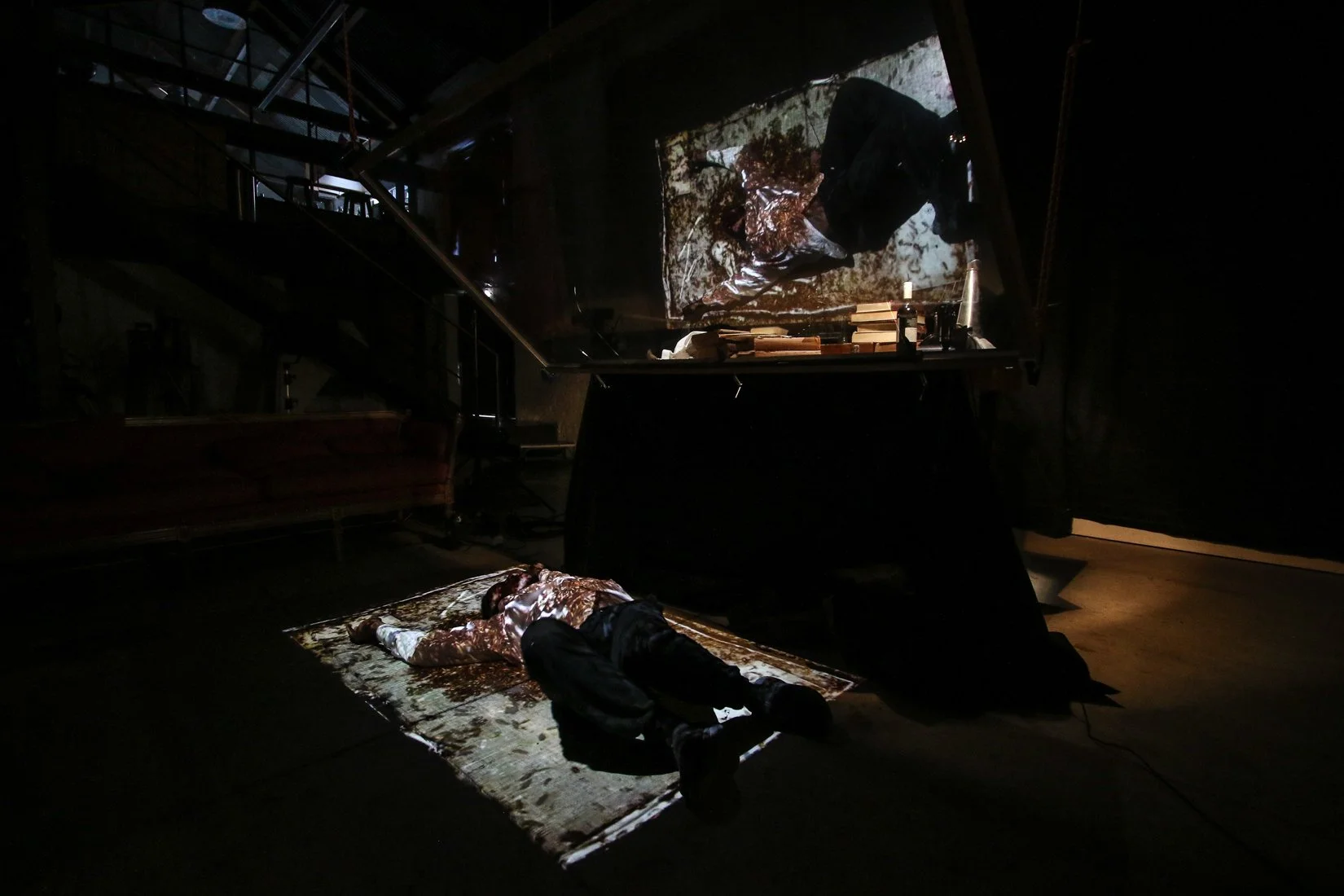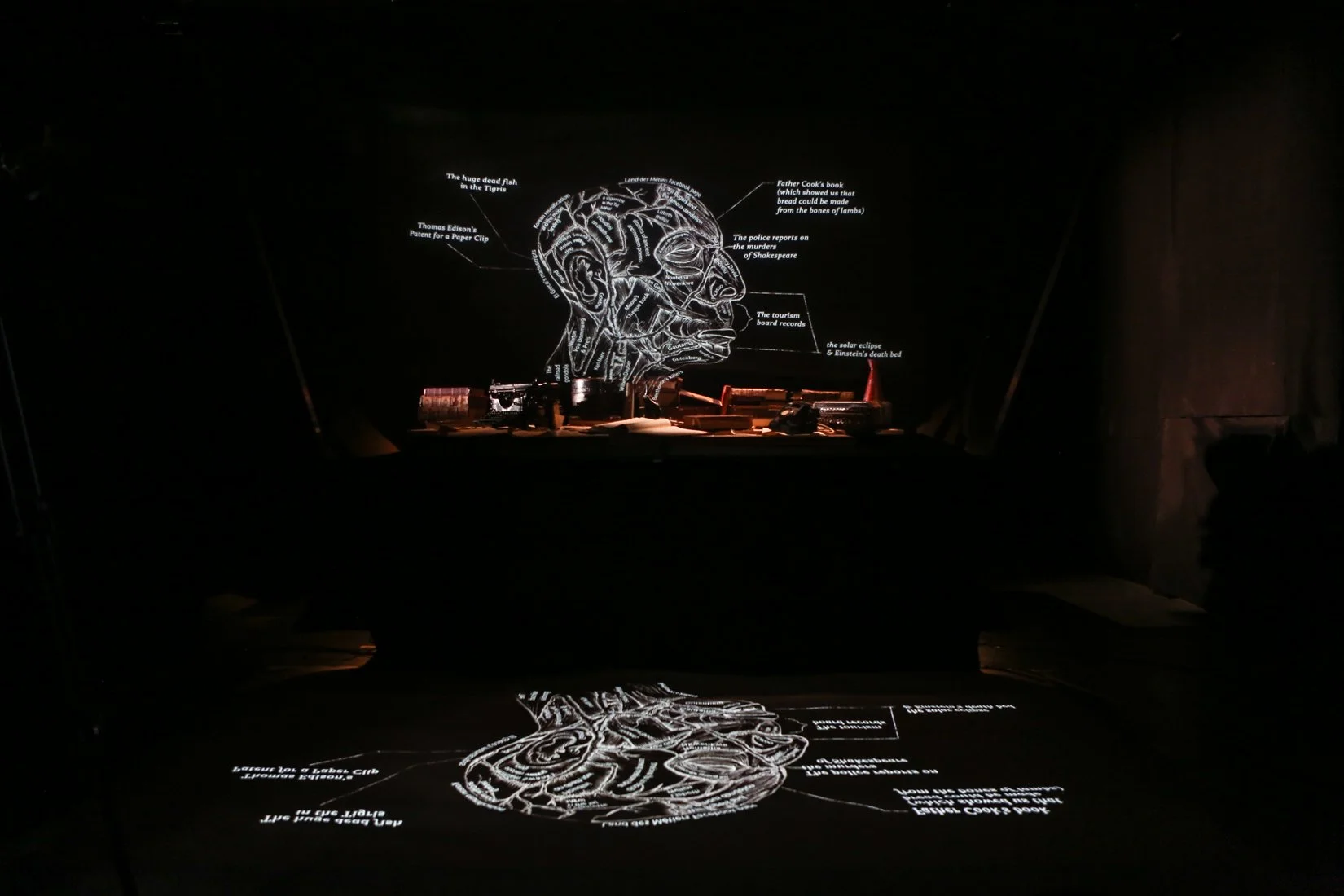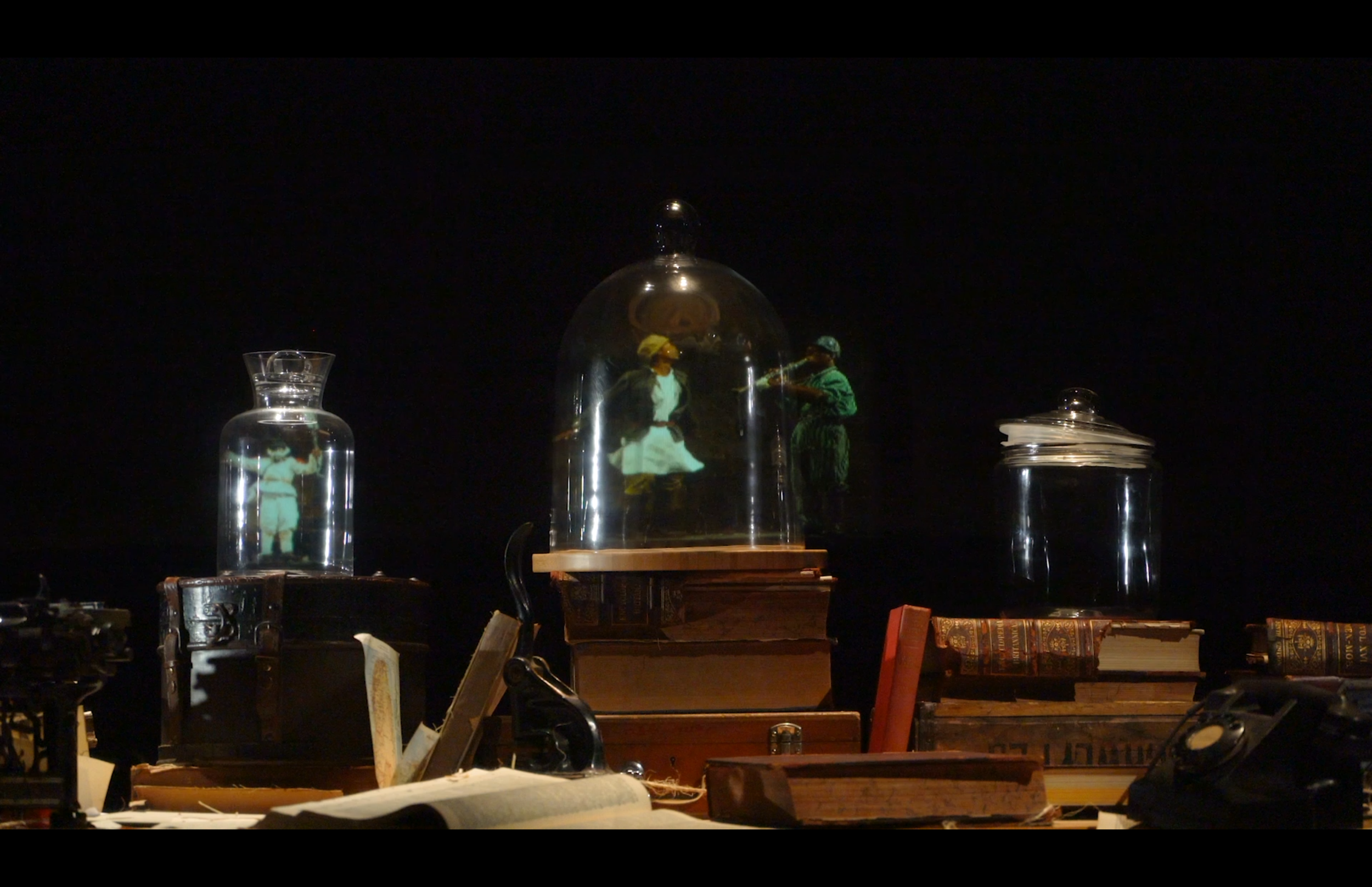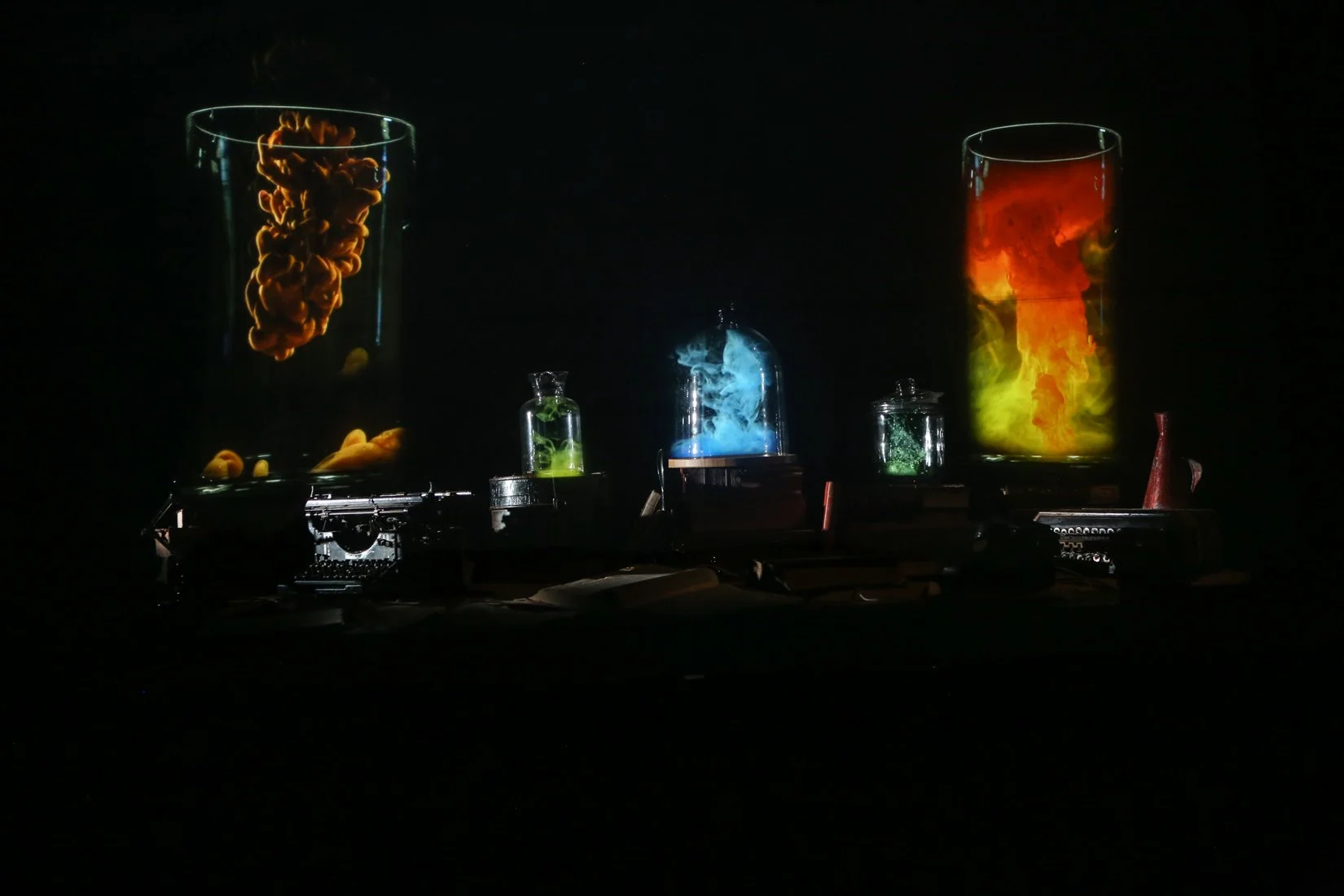AN OUTPOST OF PROGRESS
A playful interrogation of Joseph Conrad’s short story An Outpost of Progress, this is a work that merges live performance with tabletop theatre to expand on the relationship between narrator and characters, as well as the themes of power, brutality and greed inherent in the story.
We enter the story at the arrival of the two colonial administrators (Neil McCarthy and Antony Coleman), posted at a trading station beside a river in an unnamed location. It is also here that we meet their clerk and interpreter, Henry Price (Bongile Gorata Lecgoge-Zulu). What follows is a tale of miscommunication, death, betrayal, servitude, and bumbling empire, all told through compelling narration, live performance, and the hybrid live and digital theatrics of the Pepper’s Ghost.
Through McCarthy’s sharp, metered narration of events, An Outpost of Progress is a story that is told with a wry tone, and an unsettling, hand-wringing anxiety. Very quickly, things go terribly wrong for the two blundering administrators, in a series of short, sharp scenes that, altogether, function as a compelling portrait of greed and the dark side of humanity.
– David Mann
CREDITS:
TEXT | Joseph Conrad
PERFORMERS | Neil McCarthy, Antony Coleman & Bongile Lecoge-Zulu
CINEMATOGRAPHER | Duško Marović SASC
VIDEO EDITOR & COMPOSITOR | Žana Marović
COSTUME DESIGNERS | SO Academy Costume Mentees
FEAST OR FAMINE
Through Bronwyn Lace’s Feast or Famine, live physical and musical performance interact with video installation in a piece that explores mortality, mourning, fragility, and transition.
On the screen is manipulated footage taken in the basement of the Natural History Museum in Vienna in mid-2016. It is the carcass of an owl, slowly being picked clean by a community of beetles, its bones sighing and shifting as the insects work away. Then there is the human presence (Teresa Phuti Mojela) who, lying on the floor beneath the Pepper’s Ghost, superimposes herself on the footage.
In this way, she merges with the scene, writhes with the bones of the creature, bristles with the many beetles. It is a deeply affecting scene, and one made all the more compelling by the use of a pre-recorded vocal chorus – a kind of elegy for the scene we see taking place before us. But the vocals also serve as a salve for the scene. They lend an enduring humanity to the performance, an ebb and flow of warm words and whispers spoken over bodies that are picked apart and pieced back together again.
– David Mann
CREDITS:
CONCEPTUALISER & VIDEOGRAPHER | Bronwyn Lace
PERFORMER | Teresa Phuti Mojela
MUSICAL COMPOSERS & PERFORMERS | Nhlanhla Mahlangu & Xolisile Bongwana.
VIDEO FOOTAGE | Victor Neustetter
EDITOR & COMPOSITOR | Žana Marović
Thanks to The Natural History Museum, Vienna
ODRADEK
Live performance, projected imagery, and responsive music come together to shape the Pepper’s Ghost performance of Odradek.
Using Franz Kafka’s short story The Cares of a Family Man as a point of departure, Odradek plays with language, scale, physicality, and sound in a quest to puzzle out (or pay tribute to) the strange, lingering creature that dwells at the bottom of the stairs.
Employing earnest and near-etymological narration alongside the erratic and reactive movements of the creature, as well as short, sharp musical punctuation allows for an engaging and genial meditation on the themes at play in Kafka’s story – a story that countless philosophers and literary theorists have attempted to make sense of over the years.
Ultimately, as we engage with the story, observe the creature gesticulating and flailing in reverse, and hear the playfully abstract contributions of the music, it is a new kind of language – a language both spoken and embodied – that emerges on the screen and stage before us.
– David Mann
CREDITS:
TEXT | Franz Kafka’s The Cares of a Family Man
PERFORMERS | Ameera Patel & Frances Slabolepszy
MUSICIANS | Clare Loveday & Bongile Lecoge-Zulu
CINEMATOGRAPHER | Duško Marović SASC
VIDEO EDITOR & COMPOSITOR | Žana Marović
COSTUME DESIGNERS | SO Academy Costume Mentees
KEYS TO A GREAT POETIC GAME
Inspired by French philosopher-poet René Daumal’s Le Contre-Ciel, performer Sibahle Mangena explores the idea of reconciling or struggling with one’s own mind throughout the creative process.
It is a scene that is all-too-familiar: A single character sits at her desk, pen in hand. There is the crinkling of paper, the abandoned idea, the anxiety of influence. It is the creative process at its most agonising and frustrating.
Above her, and all around her, voices and versions of herself emerge, wielding loudhailers and distracting her, challenging her, offering up their ideas. The voices proliferate, and she swats them away. She chases her thoughts, channels song lyrics, pursues single words to the point of absurdity.
A battle between writer and editor, artist and critic, ensues, explodes before ultimately veering towards a resolution, and a semblance of prose from the author.
– David Mann
CREDITS:
TEXT | René Daumal’s Le Contre-Ciel
PERFORMER | Sibahle Mangena
DIRECTOR | Phala Ookeditse Phala
CINEMATOGRAPHER | Duško Marović SASC
VIDEO EDITOR & COMPOSITOR | Žana Marović
COSTUME DESIGNERS | SO Academy Costume Mentees
DIARY OF A SANE MAN
The work of journalist, linguist, translator and writer Sol T. Plaatje is right at home in Season 7 of The Centre for the Less Good Idea. Diary of a Sane Man is a close reading of the diary of Plaatje. Performed by Phala Ookeditse Phala and conceptualised and adapted by Phala and Jane Taylor, the work employs reading, projection and live performance to explore the mind of a man between worlds, languages and his own modernity.
Plaatje was just 23 when he wrote The Boer War diary of Sol T. Plaatje: an African at Mafeking, a text that he did not intend for publication. In the midst of gunfire, incoming artillery shells and ceaseless chaos over a 217-day period, he managed to provide an exquisite record of the Mafeking siege. Performed 120 years after Plaatje first penned the extraordinary account of this period in South African history, Diary of a Sane Man draws and expands on key records and reflections to provide an account of a man thinking independently through pain and great upheaval.
Phala plays the part of the narrator, and also Plaatje himself, through the digital and physical theatrics of the Pepper’s Ghost. The result is a ghostly dialogue between performer and projection, a chance to unpack the words and enduring observations of Plaatje from the author himself. As a result, the performance is both a reflection on the contents of the diary and on the act of writing itself.
Beyond these choice reflections, Diary of a Sane Man also highlights the vital work that Plaatje did as an interpreter for the courts, and the complex role of language and translation in this regard.
Notions of truth, language, and death are all extracted and held through Diary of a Sane Man. In a key moment in the play, we hear a passage from Plaatje’s diary where he is struck by what he believes to be a bullet. It is an engaging and philosophical bit of writing, a poetic account of a man grappling with his own mortality in the midst of war. “I knew at that moment that I had been transmitted from this temporary life on to eternity,” says Plaatje. “I imagined that I had the nickel bullet in my hand. That was merely the faculty of the soul recognising (in an ordinary post-mortal dream) who occasioned its departure – for I was dead! Dead, to rise no more. A few seconds elapsed after which I found myself scanning the bullet between my finger and thumb, to realise it was but a horsefly.”
– David Mann
CREDITS:
TEXT | The Boer War diary of Sol T. Plaatje: an African at Mafeking
ADAPTORS & CONCEPTUALISERS | Jane Taylor & Phala Ookeditse Phala
PERFORMER | Phala Ookeditse Phala
MAYAKOVSKY
Live performance, narration, and projected puppetry and animation converge in this adaptation of Russian playwright Vladimir Mayakovsky’s self-titled verse drama, Mayakovsky: A Tragedy.
An experimental take on the original avant-garde tragedy, Mayakovsky makes use of the illusory optics of the Pepper’s Ghost to pair the adapted text of Mayakovsky with the drawings and animations of William Kentridge. The result sees the very act of storytelling being picked apart and rendered through various temporal and visual planes.
Led by a poet protagonist, the play is a meditation on the performativity of prose. Here, text prances, parades and performs. It is spoken, written and danced. Crucially, it is also a display of language as a salve (or a form of satire) for the times we live in, and how we go about the act of living today.
– David Mann
CREDITS:
TEXT | Vladimir Mayakovsky’s Vladimir Mayakovsky: A Tragedy
CONCEPTUALISER & DIRECTOR | William Kentridge
PERFORMER | Katlego KayGee Letsholonyana
CINEMATOGRAPHER | Duško Marović SASC
VIDEO EDITOR & COMPOSITOR | Žana Marović
COSTUME DESIGNER | Emmanuelle Erhart
SPACTRAL
Language, physicality, and the Shakespearean soliloquy are run through the illusory possibilities of the Pepper’s Ghost in Spactral.
Drawing on the soliloquies of Shakespeare’s Macbeth, the performance merges live dance and movement with projected stills as well as manipulated footage. The results see novel experimentations with time, perception, and multiplicity playing out in real time.
Paper lends a distinct tactility to the otherwise ethereal work. There is the paper collar, the bristling page. It becomes a canvas for multiplicity – a story that expands and takes on greater intention as it grows.
Through the translation and puzzling out of language, time and physicality, Spactral pays tribute to both the spoken word and the body in motion, teasing the limits and functionalities of both of these modes of communication.
– David Mann
CREDITS:
TEXT | William Shakespeare’s Macbeth
PERFORMERS | Thami Majela, Kaldi Makutike & Michael Mazibuko
CINEMATOGRAPHER | Duško Marović SASC
VIDEO EDITOR & COMPOSITOR | Žana Marović
COSTUME DESIGNERS | SO Academy Costume Mentees
LIBRARY OF BABEL
Taking the story by Jorge Luis Borges as a thought experiment, this installation explores the nature of The Algorithm as creator: A collection of surreal texts, completely written by AI, plays out as a contemporary realisation of the Library of Babel.
Set against the darkened, half-silvered canvas of the Pepper’s Ghost, a series of animations, abstractions, and visual motifs leads the viewer further into the machine, as words and narratives begin to play out before us. Books pile up and fall, the pathways of thought and language widen and intertwine.
As one watches text being fed through the machine and re-authored by the algorithm, the resulting performance is a fragmented narrative that oscillates between dystopic speculation, blunt laconicism, and the machine's own cerebral ramblings, all stemming from the historical corpus of human writings.
– David Mann
CREDITS:
CONCEPTUALISER, EDITOR & COMPOSITOR | Janus Fouché
CONCEPT & RESEARCH CONTRIBUTIONS | Jane Taylor
CINEMATOGRAPHER | Duško Marović SASC
WITNESSES
Witnesses is a video-based installation which harnesses projection, materiality, and physicality in order to explore how figures perform across time and space, and how we as viewers go about engaging with that performance.
Harnessing the ghost-like, carnivalesque qualities of the Pepper’s Ghost, Witnesses is both an experiment in ways of occupying and engaging with space, and a free-spirited encounter with the incidental and surplus experimentations that take place at The Centre for the Less Good Idea.
– David Mann
CREDITS:
CONCEPTUALISER | William Kentridge
CINEMATOGRAPHER | Duško Marović SASC
EDITOR & COMPOSITOR | Janus Fouché
BEYOND THE PALE
Beyond the Pale is a video installation merging original sound and visual work through the myriad dimensions of the Pepper’s Ghost.
What can be seen as a meditation drawing on Homi K Bhabha’s Art of Multicultural Translation, the video installation features a series of glass receptacles, each housing a slow, mercurial cloud of colours. Coupled with original, responsive chorus work, Beyond the Pale presents a mesmeric show of sound, form and colour.
– David Mann
CREDITS:
CONCEPTUALISERS | Žana Marović & Duško Marović SASC
COMPOSER | Phala Ookeditse Phala
PERFORMERS | Phala Ookeditse Phala, Micca Manganye & Muzi Shili
EDITOR & COMPOSITOR | Žana Marović
Over the course of Season 7, The Centre for the Less Good Idea showcased a multimedia exhibition and installation by Bronwyn Lace titled Still Life.
STILL LIFE
Bronwyn Lace has long been a collector of things. From dead insects and animal bones, to broken glass and obsolete encyclopaedias, she keeps these objects with her until the right time to process them presents itself.
In Still Life we see Lace’s collection of bones cleaned, gilded, threaded, dutifully photographed and digitally blended into one another on a four-screen video installation. Lace’s instinct as an artist has been to use and transform the darker elements of life – death and decay, abandonment and neglect – as ingredients to foster in-between spaces or platforms portraying the significance of fragility and vulnerability.
Accompanying the video installation is a suspended and re-assembled ostrich ribcage and pelvis. This floats and turns above a refracting mirror onto which a cluster of folded pages of Encyclopedia Britannica is set. Each carefully crafted miniature invokes a sense of patience and alludes to the process of transitioning into a meditative state.
Collaboration is central to Still Life. The silent video works and installation elements find themselves in conversation with landscape music composer Anne Vanschothorst’s spoken word project klip lied snaar: voordrag van gedigte en harpmusiek, a collaborative compositional project made in response to the poetry and voice of Antjie Krog. The selected poems by Krog are ‘Still Life’, ‘Land van Genade en Verdriet’, ‘Die Ligaam Beroof’, and ‘Grond’.
Altogether, these elements make for an immersive and multifaceted installation. Relationships both incidental and intentional emerge between the various materials and artworks. There are the strings in the music of Vanschothorst and their dialogue with the threaded bones, Krog’s spoken word and its relationship to the brittle, bristling paper. The shadows, too, are in constant conversation with the darkness of the mirrors and the shimmer of the gilded canvas.
As a stand-alone installation, Still Life is a deeply affecting body of work. Read in conjunction with the performances of Season 7 of The Centre for the Less Good Idea, the installation also becomes a place of great respite and reflection – a space to ponder and process those ephemeral notions of history, language, death and memory.
– Bronwyn Lace & David Mann
CREDITS:
ARTIST & CONCEPTUALISER | Bronwyn Lace
GILDING & ORAGAMI ASSISTANT | Masetho Mohohlo
VIDEO EDITOR | Noah Cohen
PHOTOGRAPHER | Zivanai Matangi
LIGHTING DESIGNER | Wesley France
MUSICIAN | Anne Vanschothorst
POET | Antjie Krog












